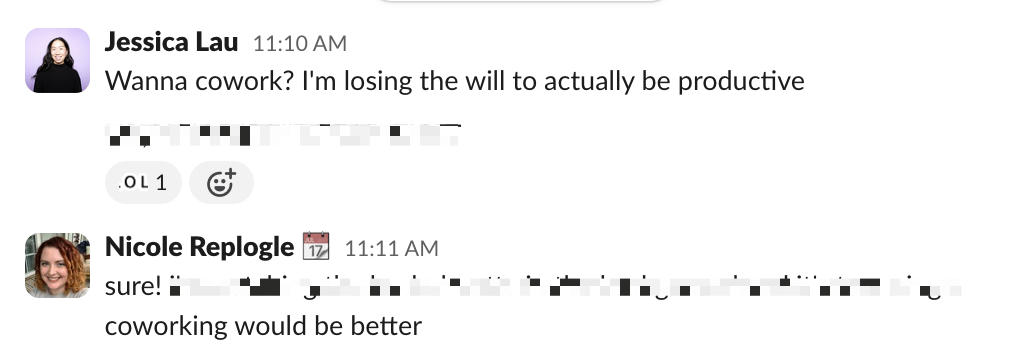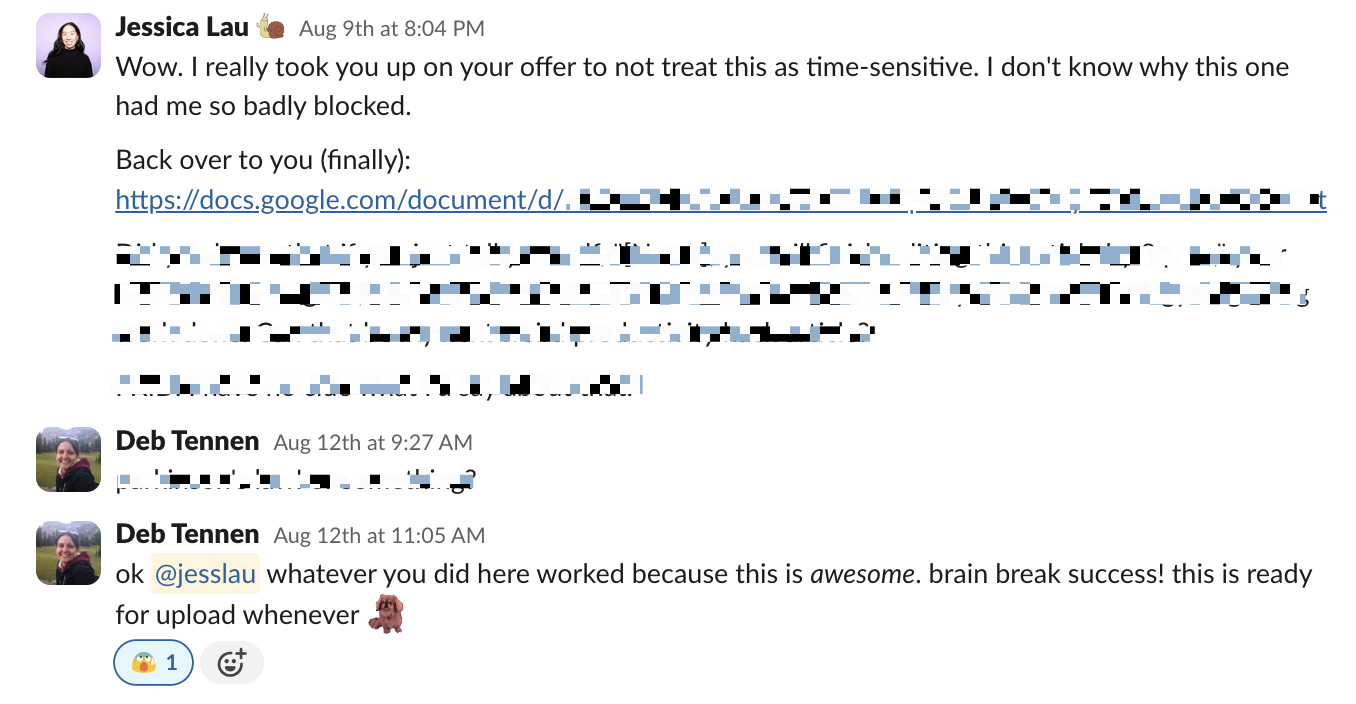At least once a day, I’ll dramatically call out to my partner, “I have no bones!” For the uninitiated, a no-bones day means you have absolutely no desire to get anything done. Of course, there’s nothing wrong with giving yourself the day to do nothing if you have that luxury. But you can only put off your to-do list for so long.
That’s why I’ve had to adopt different strategies to motivate myself to get things done (even when I really don’t want to). Here are 10 tried-and-true tips for self-motivation.
10 tips for self-motivation
Before we dive in, it’s worth mentioning that this list isn’t prescriptive—what works for one person may not work for another. I recommend picking one or two strategies that sound feasible to you and starting there. Then, after executing the strategy for a few weeks, ask yourself how things are going. Are you getting more tasks done than you were before? If yes, keep going. If not, pick one or two other strategies to try.
1. Address your reasons for procrastinating
There are so many reasons why humans procrastinate—resources, time, distractions. The problem is that instead of focusing on how to address these reasons, we stay fixated on listing all the reasons why we can’t do something. And we stop there.
To be clear, there’s nothing wrong with listing your blockers. It’s what you do with that list that matters.
So here’s what you do instead: write a list of what’s keeping you from starting—or potential blockers that could disrupt your momentum—and come up with a solution to address each one.
For example, when imposter syndrome creeps in and tells me I don’t have what it takes to be a professional writer and I should quit while I’m ahead, I turn to my kudos folder—it’s where I store compliments and positive feedback about my past work. It reminds me that I am capable and usually stirs up enough nice feelings to encourage me to start writing that article I’ve been putting off.
Or, when I know I’ll be working from somewhere with unreliable access to Wi-Fi—like when I’m waiting at the mechanic’s for an oil change—I turn on offline access in Google Docs for the article that I’m working on. This way, I don’t have to worry about losing the motivation to keep writing.
2. Visualize yourself doing the task
When I was preparing to run a half-marathon, I dreaded every single training run. I couldn’t see myself making it 13.1 miles (21.1 km for my fellow metric system users), let alone the six or nine miles my training program called for.
That’s when I learned about the power of visualization. By picturing myself crossing the finish line and rehearsing the movements required to do so, I was priming my brain and body to make my desired outcome a reality.
Ashley Rector, founder of Quimby Digital, also uses this strategy in her professional life:
“When the fog sets in, and I can’t find the motivation to complete something—or even think of beginning it—I close my eyes and picture myself already having finished it. The job is done. I stay in that moment for a minute or two. I feel it, taste it, get inspired by it. Then I open my eyes and write down what I saw.”
By imagining every aspect of what it’s like on the other side of the task at hand, you trick your brain into thinking you already have what you want and become empowered to take the action necessary to achieve those results.
3. Try parallel working
One thing I learned from my university days is that I’m far more productive doing work next to a friend versus sitting alone in my room. It makes sense—knowing that someone else is present and aware that you’re doing a task tends to increase your motivation to complete it. That’s why parallel work (or body doubling) is a common productivity strategy used by people with ADHD.
Now, if I find myself getting sidetracked by everything but the task at hand, I’ll ask my teammates to cowork over Zoom.

If a physical body double isn’t practical for you, there are other ways to find accountability partners.
When Deb Kelson, VP of Marketing at Switchboard, took a career break to write a children’s book, she let anyone and everyone know what she was up to:
“I let all my friends and former co-workers know I quit to work on a passion project, which meant I had a lot of people asking for updates. This kept me motivated through slumps.”
Although she’s returned to a corporate job, Deb’s kept up the habit, posting her intentions at work in a shared Slack channel:
“If I tell people I’m going to complete something by a certain date, I’m much more likely to do it.”
4. Hire someone (or act like you’re going to)
If you tell someone you don’t have time to do something or don’t feel like doing it altogether, there’s a good chance they’ll recommend you outsource it. Dreading the annual scrub-down of your walls? Outsource it. Need to conduct market research for a new product you’re developing, but don’t know where to start? Outsource it.
Even if hiring someone’s not on the table, doing the prep work to hire that person can be just as beneficial. Here’s why this strategy works for Axel Lavergne, founder of reviewflowz:
“When I don’t want to do something, it’s very often because I haven’t properly scoped it out. As soon as I think about outsourcing it, I start asking myself, ‘How can I explain what I need to someone who has no prior context?’ I start writing the brief, and before I know it, I’m halfway done with whatever I didn’t want to do.”
If you’re having trouble drafting the scope of work, Axel recommends explaining your issue to ChatGPT and asking it for some ideas to jumpstart the process.
5. Use a motivational app
In many ways, technology can be a distraction. But it’s a part of daily life, so why not use it to your advantage?
Take the productivity app Momentum, for example. It transforms every new browser tab into a personalized dashboard, complete with picturesque backgrounds, inspirational quotes, and widgets that allow you to set a daily focus and track your to-do list.
When the day begins, Momentum prompts you to enter your main focus for the day. Then, whenever you open a new tab—perhaps with the intention of checking something unrelated to what you’re supposed to be working on—Momentum reminds you of your goal. This reminder can provide that crumb of dopamine needed to get work done.

If you want to get fancy, you can create a personalized motivational coach bot with Zapier and OpenAI. With it, you can ask your bot to provide positive affirmations, offer advice, or put together concrete action plans to help you achieve your goals. Learn more about how to create a custom AI chatbot.
6. Set goals and track your progress
If you’ve ever completed a survey, you’ve likely seen a progress bar run across the top (or bottom, as shown in the example below) that indicates how many more questions you have left to answer.
By showing how close you are to the goal (finishing the survey), the harder or faster you’ll work to complete the goal. This idea is called the goal gradient effect, and it applies to any goal.

Breaking down your goal into smaller steps and tracking your progress may be especially helpful if you’re working on a large project. It allows you to focus on one thing at a time, making your overall goal seem much more manageable.
7. Reward yourself
This self-motivation tip goes hand in hand with setting goals. Creating incentives for finishing your task or achieving a certain milestone can also boost your motivation to get things done. When I find myself dreading a task—like submitting all my monthly receipts for reimbursement—I promise myself a treat once I’ve finished the chore.
It sounds small, but dangling this carrot is enough to convince me to push through. Of course, the bigger the task, the bigger you may want to make the reward.
One other thing to keep in mind is that the motivation to get a task done is greater when presented with an immediate reward. If there’s a significant delay in receiving the reward, the incentive may not act like an incentive at all.
8. Change your environment
When you feel like you’re living your own version of Groundhog Day—you eat the same breakfast, you ride the same bike path to and from work, and you stare at the same four walls five days a week—it’s easy to fall into a rut.
That’s why it’s important to switch up your surroundings. When you do, you introduce a sense of novelty that activates your dopamine system and, as a result, feel a boost in your overall mood, outlook, and motivation.
This is the same self-motivation tip fellow writer Amanda Jackson uses when she’s in need of a boost:
“When I’m not feeling creative, I switch up my normal location—going from my desk to the comfy chair in my bedroom and going to the library instead. I’ve heard other people say they’ve even worked from their bathtub! A new environment kickstarts my motivation mode and gets me ready to work.”
9. Do something else
Whenever I hit writer’s block, my editor regularly encourages me to switch things up—whether that means working on a different article, listening to a podcast, or taking a hike (not a euphemism). It sounds like a counterintuitive way to get things done, but it works.

By switching up activities, you engage different parts of your brain. This mental break might be exactly what you need to feel refreshed and inspired to return to your original project.
10. Give yourself downtime
Maybe actively doing something else isn’t what your brain needs. Perhaps what it really needs is to do nothing at all.
In his book, Rest: Why you get more done when you work less, author Alex Soojung-Kim Pang talks about the importance of downtime and emphasizes why work and rest are not opposites, but complementary.
He broke down the schedules of highly successful people from various industries—from scientists to artists—and found a similar schedule: work diligently for four to five hours, and spend an equal amount of time on deliberate rest.
The key here is to embrace rest (or any activity that isn’t directly “productive”) as a valuable use of your time—it’s what allows you to get back to work feeling recharged and ready to go.
Inspiration is all around you
I’m hoping that at least one of these self-motivation tips will give you the burst of energy you need to finally tackle that project you’ve been putting off. Once you’ve found your momentum, here are a few additional productivity pointers to help you make the most of your time:
This article was originally published in March 2019 by Justin Pot and has also had contributions from Liz Melton. The most recent update was in September 2024.